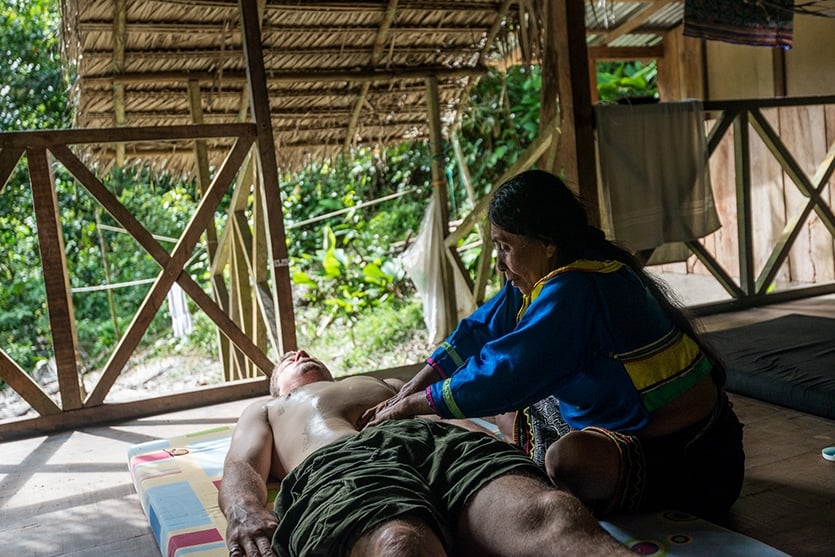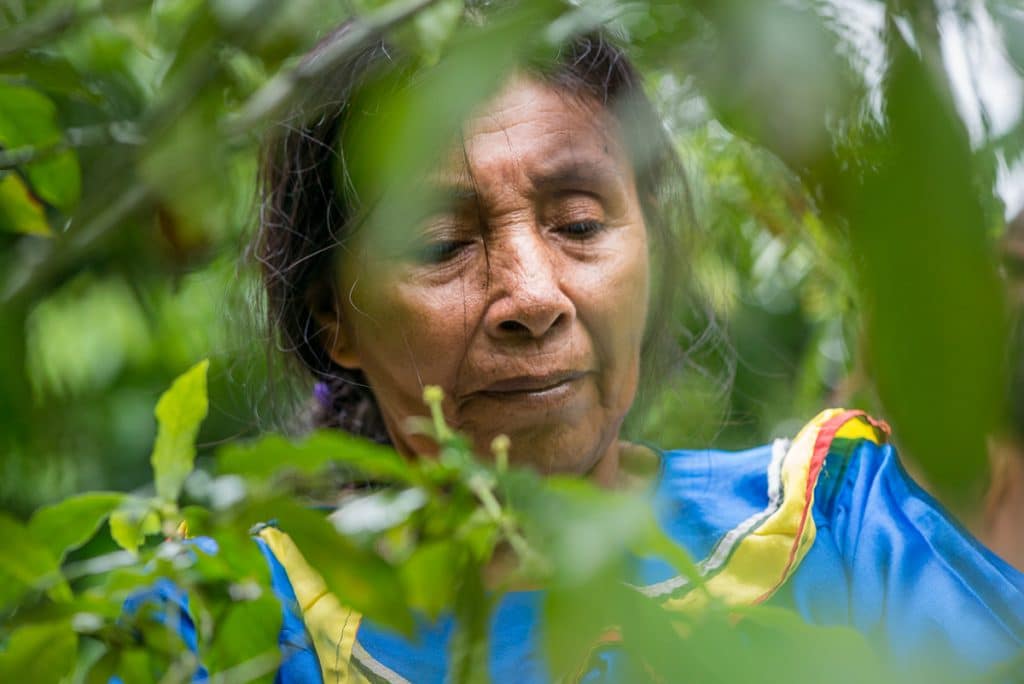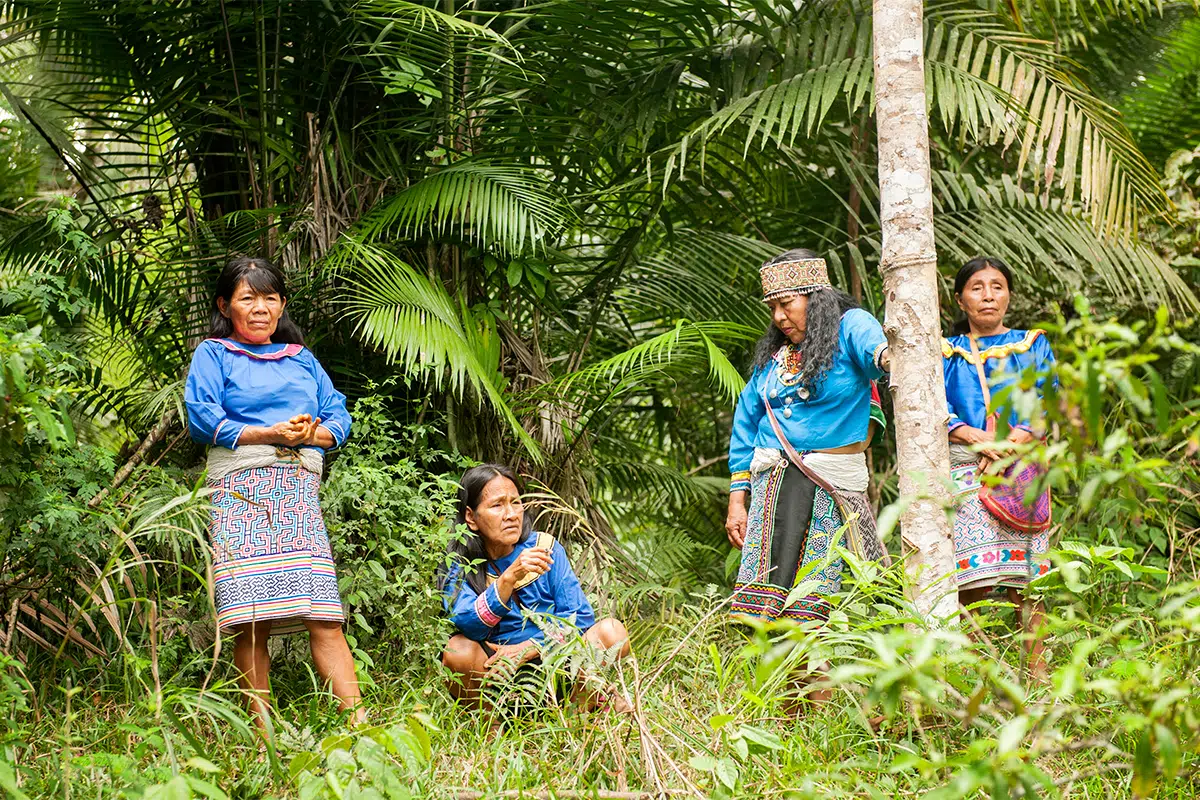The anticipation is palpable as we wait for our unconscious to emerge from the darkness. The majestic wooden structure we’re in, surrounded by jungle, has transformed into a canvas of pure black, lit by flickers of bright orange from burning tobacco, as six female Shipibo elders vigorously fill the space with smoke. We may not be able to see them, but they can see us—and they’re preparing to perform metaphysical surgery on our bodies.
At the Temple of the Way of Light in Peru, we call these women “las maestras,” or the teachers. Every two months, they journey from Pucallpa—a city in eastern Peru along the banks of the Ucayali River—to Iquitos—a populous and polluted city located in the northeast of the country, often referred to as a “gateway” to the Amazon. Then, these women, some of whom are in their seventies, take a mototaxi to the shore of the Nanay River, followed by a short boat ride down the river, and trek two miles through the rainforest arriving, once again, to the Temple.
When they first introduce themselves to us—23 women of all ages, from around the world, who have come to this place to drink ayahuasca—they tell us four things: their Spanish name, their Shipibo name (and its significance), how far their village is from Pucallpa (which they use as a reference point), and how long they’ve been working with “la medicina.” We’re sitting in a circle in the maloka, the large, circular structure that will hold us for five nights as we journey into what we already know, but have not yet seen. The straw, conical roof is held up by fierce wooden beams resembling a yacht—and we’re surrounded by green mosquito netting looking out into the jungle.
“Necesitas concentrarse [you need to focus],” las maestras emphasize, as we prepare to drink ayahuasca, many of us for the first time. They’re wearing traditional Shipibo clothing: solid, longsleeved shirts in bright yellow, green, red, blue, and pink with a multicolored ruffle along the collar line. Their skirts are intricately woven tapestries containing fractal-like zigzags of the visions they have on ayahuasca. This is what you’ll see too, they tell us, delicately tracing the patterns on their skirts. As they slide their olive-complected fingers along the embroidery, they whisper eerie lullabies—the sacred melodies, called ikaros, gifted to them by the plants and, also, visually represented by these patterns. In the Shipibo medical system, it’s these songs, more than the ayahuasca itself, which does the healing.

The first night in the maloka, I was unable to focus on the ikaros. I flailed around like a petulant child in timeout: rolling from one side to the other, kicking my legs, and moaning disruptively. “You’re trying to escape,” the facilitator, a 34-year-old woman from upstate New York, trained to assist las maestras, informed me. “You’re trying to escape what’s inside of you.”
The next day, las maestras reminded me again of a phrase which would soon become my mantra: “necesitas concentrarse.” Their eyes convey gentleness, but their instructions are firm and unwavering, a reflection of their devotion to the plants.
Read: The Ayahuasca Privilege

The female healers at our retreat—Diana, Teresa, Rojelia, Olga, Elena, and Anita—all inherited the tradition of serving ayahuasca from family members, who inherited the tradition from their family members, going back as many generations as they can remember. They all became healers one of two ways, says Matthew Watherston, founder of the Temple: Either they were identified at a young age by family members as a person chosen to walk the path, or they felt a calling after treating a personal health crisis with plant medicines.
How to Grow Shrooms Bundle
Take Both of Our Courses and Save $90!
“Some of them had ayahuasca dropped in their mouths when they were born, and began participating in ceremony at two, three, four, or five years old,” says Watherston. “Many healers started to diet [or apprentice to become a healer] at a very young age, some from 10 years old.”
The dieta, as it’s called, is the training required to become a female healer, called a curandera (in Spanish) or an onanya (in Shipibo). The practice entails strict isolation in the jungle, where the apprentice, instructed by an experienced maestro or maestra who periodically visits, consumes plants, typically beginning with smaller shrubs and working their way up to large trees. (This dieta differs from “the dieta” that foreigners are often instructed to partake in prior to an ayahuasca ceremony, which typically entails refraining from sex, drugs, pork, and other foods.) While training has become more lax in recent years as curanderismo has grown in popularity, Watherson says he looks to hire maestros and maestras who have done a minimum of three, one-year dietas in isolation, combined with a variety of shorter dietas.
The purpose of the dieta is to connect with the spirits of the plants, which, the Shipibo believe, can only be done when a person shows the plants a deep devotion to them. Then, over time, the spirits of the plants reveal themselves, as the apprentice learns to listen. It’s during this time that the apprentice also hears the plants teach them their own unique ikaros.
“When a person comes to me, I fast and pray before I pick out the plant, and I give them a mapacho [sacred tobacco],” says Manuela Lopez Fasanando, the vegetalista, or herbalist, responsible for all the plant remedies at the Temple, other than ayahuasca. “The plants tell me in my dreams how to help people.”

Nobody knows for sure, but the Shipibo, one of the two largest indigenous groups in Peru alongside the Asháninka, have been drinking ayahuasca for at least centuries, perhaps millennia, in the jungle surrounding Pucallpa. Nobody knows either, exactly how many different ways indigenous groups drink ayahuasca, but Chris Kilham, an ethnobotanist known as the “Medicine Hunter” and author of The Ayahuasca Test Pilots Handbook, estimates there are at least 100 varying traditions in Amazonia, from how the ceremony is conducted to how the ayahuasca brew, itself, is made.
Among them, the Shipibo are by far the most prominent indigenous group serving ayahuasca to foreigners. Kilham hypothesizes that, in addition to the sheer size of their population, this is due to the strength of their traditions and the location of their communities along the river in Pucallpa, where, as far back as the 1950s, they were easily encountered by Western travelers in search of the medicine. It’s only been within the last decade or so, however, that the areas around Pucallpa and Iquitos have really been revived by what’s now referred to as the “ayahuasca tourism industry.”

As recently as 2007, when Watherston first came to the Amazon in search of ayahuasca, he struggled to find maestros who he trusted, let alone any maestras. “Back then, I was a train wreck,” he recalls. “From the outside, I had a picture-perfect life. I was married, I had two kids, a house, a nice car, but on the inside I was a mess.”
Upon returning to his “picture perfect life” in the UK, Watherston lost his entire identity in what, to him, felt like overnight: His wife left him and took the kids. He lost his house, his job, his car. Throughout the existential chaos, the only thing he could hold onto was an unmistakable vision from his second ceremony in the jungle, which “lit his soul up like a Christmas Tree”: It was his dharma, or spiritual path, to open an ayahuasca retreat center.
Watherston, 32 at the time, went back to the Amazon and began chipping away at his vision with the maestro who had previously conducted his ceremonies. But it didn’t take long for him to start doubting his partner. He experienced the most common symptoms of a spiritual seeker who has fallen prey to the particularly pernicious manipulation of a phony healer: simultaneous confusion and unblinding devotion. It wasn’t until he fell in love with someone at the newly-established Temple, his now-wife Klara—who told him the maestros were asking her to do things like pull down her pants so they could heal her ovaries—that his blinders were ripped off. Sexual assault and abuse, unfortunately, continues to be a problem among rogue healers in the region.
“I had been there with good intentions, a gringo with money, and I basically got taken for a ride,” he says. “I shut the Temple down, it just wasn’t responsible to continue. I didn’t know what to do. I ran away, kind of with my tail between my legs.” The modest beginnings of the Temple we know today—500 acres of jungle, including an ecological sustainability nonprofit called The Chaikuni Institute established in 2012—were left to decay.
Read: Consent is Psychedelic: Here’s Why

Then in January 2008, as Watherston puts it “serendipity rang.” He was back in the UK when he was invited to drink ayahuasca with eight Shipibo healers outside Pucallpa. The best part? They were all women.
Following the three ceremonies that Watherston did with the maestras, they told him he had been manipulated while under the influence of ayahuasca. Brujería, or witchcraft, they called it. He opened up to them about his story: his vision of a retreat center, and how the Temple was now sitting abandoned in another part of the jungle.
“Essentially it was a win-win situation,” he says. “They were masters of the art of plant-spirit healing, but it was not really being valued by local people, or providing them an income. Back in those days, they were mainly selling their crafts on the streets of Pucallpa to earn money to support huge extended families.”
In February 2009, Watherston returned to the Temple with las maestras and, together, they started over. This time, the design of the ceremonies was entirely driven by the women, something that’s rare in Shipibo communities and at retreat centers.

Prior to every ceremony at the Temple, we all received a “flower bath,” a baptism of sorts as las maestras dumped cool water infused with calendula, basil, and other sweet Amazonian herbs over our heads. We were instructed to let the water air-dry so each day, following the cleanse, we waited—many of us, by choice, naked and covered in delicate, bright orange flowers—by a lagoon on the property.
How to Grow Shrooms Bundle
Take Both of Our Courses and Save $90!
It was lovely, but the silent anticipation was already humming between us: In just an hour we’d meet in the maloka to, once again, embark within. During the ceremony, las maestras offered us two main tools for moving through our experience: the traditional tobacco called mapacho, and raoininti, a perfume made from about fifteen small aromatic plants used by plant-spirit healers to attract positivity into life. After we each approached the center of the maloka to drink our dose of ayahuasca—determined by our intentions and sensitivity—we’d return to our foamy rectangular mats, positioned in a circle around the perimeter of the structure.
Then: stillness.
Each night, I’d wait for one of three signs that there was no turning back: crying, sighing, or some other sound indicating one of my fellow journeyers was in it; a restless tingling throughout my body; or an almost inaudibly high and tender voice beginning the night’s first ikaro, reminiscent of a prepubescent boy singing a hymn in an empty cathedral. The singular voice—opening the gates of other dimensions, both felt and seen—would soon swell into a chorus of seemingly-infinite rhythms and harmonies—which I sometimes felt, literally, in my body as a snake slithering through my gut, or as a clock with gauges clicking in my brain.
Read: Can Psychedelics Rekindle Ancient Animism in Modern Society?

“The plants tell me which ikaro to sing to which person,” says Rojelia Velera Gonzales, a 63-year-old healer who has been serving ayahuasca for thirty years. “Then, the ikaro comes to the body of the person. It penetrates their body and it heals them.”
For six hours, las maestras took turns kneeling in front of each of us—singing, blowing smoke, and spitting the raoininti on our heads (a tradition the Temple jokingly calls “a Shipibo shower”). What they’re doing, Watherston explains, is first diagnosing the person (identifying their depression, their fear, their trauma or whatever else may be holding them back), and then cleaning the residual energies that are trapped in the person’s body. Along with the energies that they’re unsticking (the word the healers use is “desconectar,” or disconnect), they’re also clearing out the narratives we have about ourselves that are stuck to those energies, says Watherston, narratives like “I’m not good enough” or “no one will ever love me.”
“They clean the inner wound, they clear the residual energies, and then they essentially hunt for the fragmented pieces of the soul and call them back into the system,” he explains. “I’ve experienced it myself and I’ve seen it time and time again. When it happens, the life force starts to flow properly again, you literally experience a new breath of life: There’s more strength, groundedness, heart, and connection with oneself.”

At the Temple, and other reputable retreat centers like it, the guests don’t get the most traditional experience possible, says Kilham, but “it’s a beautiful and inspired invention, which provides remarkable opportunity for revelation.”
The Temple hosts nine to 23-day programs, which include five to seven ayahuasca ceremonies; five daily cups of herbs and juices; a warm beverage made of lemongrass, which we’re instructed to chug until we vomit; and a sweat purge, in which we’re wrapped like burritos in thick wool blankets filled with steam. Yes, it was intense. Whereas a village healer may send a person home with one specific plant remedy—or conduct one ceremony—and see if it heals them, foreigners at retreat centers get what Kilham calls “the whole shamanic trick bag.”
Zoe Helene, founder of Cosmic Sister, an environmental feminist advocacy group that supports women’s voices in the sacred plant community, points out that the beauty of this cultural exchange is that it’s once again making curanderismo a viable life choice in Shipibo communities. Two decades ago, she says, Shipibo youth considered curanderismo to be a thing of the past, instead aspiring to move to Lima or other metropolitan areas and have what they considered modern lives.
“The interest in ayahuasca among foreigners has not only been economically beneficial for a whole lot of people, it’s been remarkable for helping to preserve and protect the completely dying and vanishing art of shamanic practice,” says Kilham.
The most important thing, Kilham, Helene, and Watherston all emphasize, is that the extraordinary healing the Shipibo are giving to foreigners comes back to them in a cycle of what’s called sacred reciprocity. “What are you doing for the indigenous Amazonian people, other than just attending an ayahuasca retreat?” asks Helene. “What are you doing for the precious environment they steward?”
At the Temple and throughout the global ayahuasca community, people use the term ayni to refer to the concept of reciprocity which, they say, in and of itself is essential to healing. It doesn’t just simply mean to “give back,” but, rather, speaks to the interconnectedness of all things, from ourselves to the trees to the metaphysical spirits. In the context of plant medicines, this could look like a donation to indigenous communities who are fighting foreign oil and mining extraction in their territories—or drinking ayahuasca at centers, like the Temple, which have reciprocity programs already in place.

When the final ayahuasca ceremony came to a close, there was nothing left to do but laugh—outrageously, from the deepest depths of our guts, like we’d been waiting to our whole lives. One person laughed and then another and then another until we were roaring, all 23 of us and las maestras, permeating the room with light.
Las maestras laugh often. Their giggles can be heard from the open-air structure, where they pass their days embroidering, lying in their hammocks, and calling loved ones in Pucallpa on their cell phones. It can all feel incredibly heavy, this plant medicine journey, but the energies do eventually clear. At least, they did for us, as we trekked out of the jungle, enveloped in gratitude. Thank you for giving me my life back, one woman said, with tears in her eyes, as we bid goodbye to las maestras. Thank you for reconnecting me with myself, said another. We’ll be here, they told us, come back anytime.
*This article originally appeared in DoubleBlind Issue 3.
Interested in having a psychedelic experience, but don't know where to start? Get our definitive guide on trusted legal retreat centers, clinical trials, therapists, and more.



